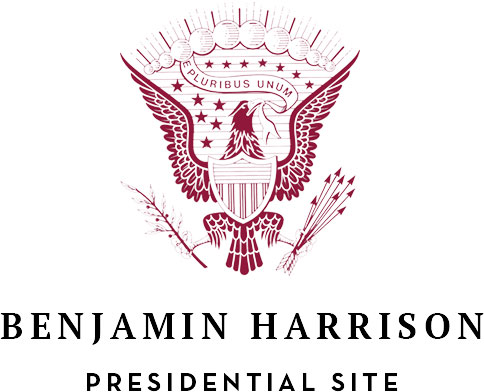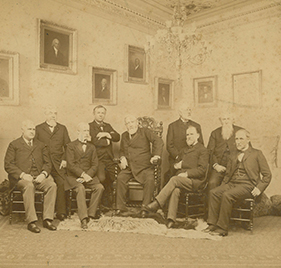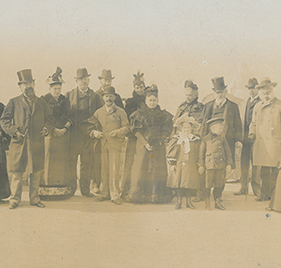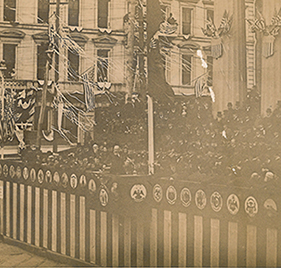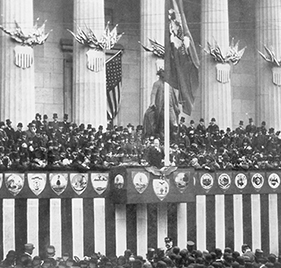

The President
 Back to Benjamin Harrison
Back to Benjamin Harrison
- Early Years
- Harrison’s Indianapolis
- The Civil War
- The Lawyer
- The President
- Caroline Scott Harrison
- Mary Dimmick Harrison
The President
Benjamin Harrison is the only United States president elected from the State of Indiana. Not only was he the 23rd president (serving from 1889-1893), but he was also the centennial president, inaugurated 100 years after George Washington.
Harrison put national strength first, yet arbitration and noninterference would be the policy. He proclaimed:
“We have a clear right to expect that no European government will seek to establish dependencies upon territory off…independent American States.”
Harrison was truly one of the first American presidents to succeed in foreign policy and matters beyond our shores. He increased the nation as a player in global trading and therefore dealt with the resulting tariff issues.
Relations with Central America were established during his presidency. The Pan-American Games is a lasting institution created from this alliance.
When Secretary of State, James G. Blaine became ill in 1890, Harrison played a larger role in directing foreign affairs. His knowledge of international law guided him in making policy. He was especially interested in improving relations with Central and South America. The first Pan American Congress, officially called the International American Conference, met in Washington on October 2, 1889. The conference recommended that reciprocal commercial treaties be entered into with the United States.
Our strength as a naval power and the build-up of all national armed forces can both be attributed to our 23rd president. Harrison was of the opinion that our army and navy should not be just a conscripted institution, but one that attracted competent, highly professional people who were interested in making the armed forces a career. Our role in global affairs expanded without a war or the sending of American troops to be stationed abroad.
Expansion of the Navy
In 1888, the United States Navy did not have any battleships. The roster of ships included 19 harbor defense vessels, two rams, two armored cruisers, and 38 unarmored cruisers. In Harrison’s Inaugural address March 4, 1889, he declared that:
“… the construction of a sufficient number of modern warships… should progress as rapidly as is consistent with care and perfection in plans and workmanship.”
Harrison chose Benjamin F. Tracy to fill the cabinet position of Secretary of the Navy. Harrison and Tracy were both concerned with the fact that at the close of the Civil War the United States had the largest navy in the world but had dropped to the bottom of the list of naval powers by the late 1880s.
After the Civil War focus was on rebuilding the country. Harrison and Tracy knew that the commercial growth experienced during the industrial revolution would take America into world markets and world affairs. Without a strong naval fleet ships were easy prey for pirates.
There was also a growing concern with defending our coast lines and shipping routes, threats of Chilean hostilities and European interventions. Tracy called for the production of not merely unarmored cruisers, but of “sea-going battle-ships.”
Tracy recommended two fleets of armored seagoing ships. Twelve ships would be assigned to the Atlantic and Gulf coasts and eight to the Pacific. He felt that the United States did not really have a Navy since it did not possess any battle ships. Harrison released the substance of Tracy’s report in November 1889. Harrison fully agreed with the need for a two coast navy. This was the first time a proposal had been made to station a fleet of substantial size in the Pacific. In his third annual message Harrison said:
“…it is essential to the dignity of this Nation and to that peaceful influence which it should exercise on this hemisphere that its Navy should be adequate both upon the shores of the Atlantic and of the Pacific.”
The first Federal legislation was the “Naval Appropriations Act” of March 1891 which authorized “$25,000,00 for arms and equipment for the naval militias, as the Secretary of the Navy would deem necessary per regulation.” The construction of the battle class ships the Oregon, Indiana and Massachusetts soon began. Now the search for armor and armament contractors would be forefront.
By the end of 1890, the steel cruisers Baltimore, Charleston, Philadelphia, and San Francisco, the gunboats Yorktown and Petrel, the torpedo boat Cushing, and the dynamite cruiser Vesuvius were all in service. Another twenty vessels (sixteen holdovers from Cleveland’s administration) were in various stages of construction.
1891 saw the commissioning of the gunboats Concord and Bennington, the cruiser Newark, and one monitor. Harrison’s administration gave the country’s navy nineteen new vessels including two 12-inch and six 10-inch guns; most of the armament was made in the United States. There were also eighteen more vessels under construction. Some would mount 13 inch guns, and all armament would be domestically manufactured.
The Harrison administration through the Civil Service Reform Act greatly improved the work force at the naval yards. The New York Navy Yard claimed a twenty-five percent reduction in cost after the reforms were in place. The workers were no longer used as political pawns, and the work force did not change after each election.
Tracy’s final report in 1892 warned the nation not to let its guard down. The Harrison administration saw one of the most rapidly expanding periods in modern naval history. The United States could compete with the modernized sea powers of the world.
Forest Reserves and National Parks
Harrison was the pioneer of national forest reserves. Harrison loved the outdoors; three times he visited Yellowstone National Park, the first park, created in 1872. While serving in the Senate, he helped limit the number of acres leased to hotels to 10, and in 1882 he introduced a bill to set apart a tract of land lying on the Colorado River. The bill failed, but in 1919 the Grand Canyon National Park was finally created. In 1890 he asked Congress for legislation that would provide for the end of the rapid and needless destruction of our great forests.
During his administration in 1891, Congress passed the Forest Reserve Act, granting the president the power to establish forest reserves. Harrison set aside land in Wyoming to form the nation’s first forest reserve. He used the act 17 times setting land aside in Colorado (including Pikes Peak), Oregon, California, Washington, New Mexico Territory, Alaska Territory, and Arizona Territory. In 1907, forest reserves were renamed “national forests.”
Harrison opened our second, third, and fourth national parks, set aside the first military park, the first urban park, and the first prehistoric Indian Ruin to come under federal protection, Casa Grande, Arizona. On September 25, 1890, Sequoia National Park was created.
The Yosemite Reserves Act passed by Congress October 1, 1890, and signed into law by Harrison, created Yosemite National Park. That same day Harrison added land to Sequoia and created General Grant National Park. Sitka National Historical Park has the distinction of being the oldest federally designated park in Alaska. It was designated as a federal park by Harrison on June 21, 1890.
Bering Sea Fur-Seal Controversy
During much of Harrison’s administration the United States and Great Britain were involved in a dispute over the regulations of the fur-seal industry in the Bering Sea. Harrison’s main objective was the protection of the seals that were quickly being exterminated. The previous policy had allowed for open-sea sealing. After Alaska was purchased by the United States in 1867, a closed sea doctrine was invoked for the first time.
Between 1887 and 1890, negotiations were carried out between Russia, Great Britain and the United States with a view to a joint convention, but the parties were unable to agree on regulating sealing in the open seas. America had seal nurseries on the Pribiloff Islands and Russia on the Komandorski group. Neither Great Britain, nor its then colony Canada, had land access to the Bering Sea or seal-breeding grounds. Thus, to prohibit open-sea sealing would have been to exclude Britain from the industry. The British did not accept this policy. The matter was sent to an international court of arbitration in Paris. In 1893, they ruled against the United States.
Immigration
Immigration in the late 1880s began to increase alarmingly and without a uniform process. In his Inaugural address Harrison stated:
“Our naturalization laws should be so amended as to make the inquiry into the character and good disposition of persons applying for citizenship more careful and searching. Our existing laws have been in their administration an unimpressive and often an unintelligible form. We accept the man as a citizen without any knowledge of his fitness, and he assumes the duties of citizenship without any knowledge as to what they are. The privileges of American citizenship are so great and its duties so grave that we may well insist upon a good knowledge by him of our institutions. We should not cease to be hospitable to immigration, but we should cease to be careless as to the character of it. There are men of all races, even the best, whose coming is necessarily a burden upon our public revenues or a threat to social order. These should be identified and excluded.”
In 1903 a law passed excluding anarchists, or persons who believe in or advocate the overthrow by force or violence of the Government of the United States or of all government or of all forms of law, or the assassination of public officials; prostitutes; and persons who procure or attempt to bring in prostitutes or women for the purpose of prostitution; those who have been, within one year from date of the application for admission to the United States, having been deported as being under offers, solicitations, promises or agreements to perform labor or service of some kind.
Opening of Ellis Island
In 1891, Congress established the Bureau of Immigration within the Treasury Department. In 1892, Ellis Island opened.
In 1855, New York City created Castle Garden, the first formal receiving station for immigrants anywhere in the world. In 1890, during Benjamin Harrison’s administration, Secretary of the Treasury William Windom ended New York State involvement due to corruption. Windom announced that the United States government would build a new receiving station on one of the federally owned islands in New York harbor.
Secretary William Windom’s first choice for the new immigrants’ station was Bedloe’s Island. The choice of Bedloe’s Island, the site of the recently erected Statue of Liberty, met with public outcry and objection. Thus work began on improvements to Ellis Island in April 1890. In May, Congress appropriated $75,000, and in July, work began on dredging a channel for better ship access. Next crib works for landfill were built to increase the size of the island.
Construction of the buildings took a year and a half. During the construction Congress created the Bureau of Immigration under the Department of the Treasury. Colonel John Weber was appointed first Commissioner of Immigration. Ellis Island, 27 1/2 acres of landfill in the upper New York Bay, opened January 1892.
1890 McKinley Tariff
The McKinley tariff set the average ad valorem tariff rate for imports to the United States at 48.4% which protected U.S. agriculture. Harrison felt that the protective tariff should be maintained and fairly applied to the products of our farms as well as of our shops. The bill met with much criticism; some felt the clause allowing for reciprocal trade agreement with favored nations weakened the bill. Harrison and Blaine strongly fought for this clause promoting friendly agreements with Central and South America. Harrison often defended the McKinley tariff.
1890 Sherman Antitrust Act
The Sherman Antitrust Act, formally known as the Act of July 2, 1890, was the first United States federal government action to limit monopolies, and is the oldest of all U.S. antitrust laws. The passing of this act fulfilled one of Harrison’s campaign pledges. The Act was signed by Harrison in 1890 and was named for its author, Senator John Sherman of Ohio.
Domestic policy is the one area that will forever haunt the memory of Harrison’s presidency. During the Gilded Age, the spoils system ruled the day. The Republican Party was less than pleased with Harrison because he made his political appointments based upon ability, not as favors to the political machine.
The House of Representatives was run with an iron fist by Speaker of the House Thomas Reed. Public business that ran counter to Reed’s wishes was held hostage by faction and filibuster. The House became a vehicle of implementing the Speaker’s wishes, and he gave little regard to Harrison. For example, Harrison wanted civil rights legislation addressed during his presidency. It was never prioritized and docketed due to a congress that would not budge from its own agenda.
Many Republicans wanted to move from the gold standard to a new silver standard as a backing for the nation’s currency. Many lending institutions and corporate powers balked, and the value of the U.S. dollar plummeted. During the “panic,” many prominent people (including some of Harrison’s own cabinet members) lost great fortunes.
At about the same time, congress approved the McKinley Tariff into law. This would tax incoming goods at a higher rate and hopefully encourage people to buy American made products. U.S. businesses, feeling the sting of recessions, tried to compensate for lost revenue by raising the prices of goods. The backlash by consumers against the Republican Party was devastating, eventually removing the president and a significant number of congressmen in the 1892 election.
In 1892, Benjamin Harrison lost more than an election; in October, his wife Caroline died in the White House due to complications from tuberculosis.
Benjamin Harrison paved the way for the future success of the Republican Party. He helped introduce civil rights legislation and established relations with Central America—resulting in the Pan-American games. But most importantly, he helped unite the factions of the Republican Party after the fallout created by Congress and helped to create a unified party that would win the White House back in 1896.

ATTENTION VISITORS
The Benjamin Harrison Presidential Site will be closed from Saturday, May 25-Monday May 27 in observance of Memorial Day.

Thank You!
Thank you for being an important part of the Presidential Site and sharing a legacy in action!

